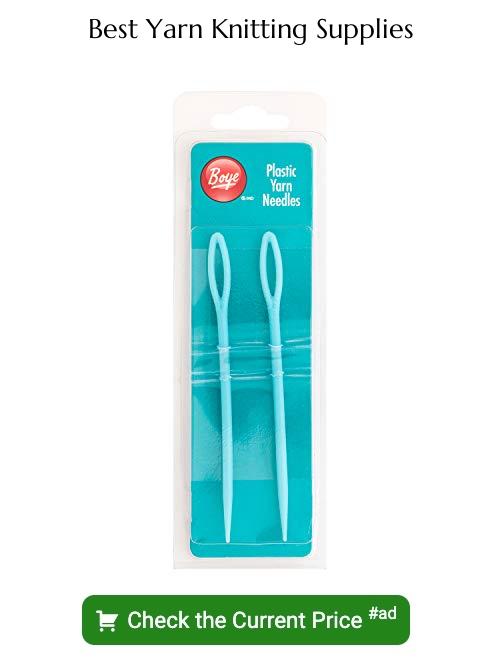Dive into the textural world of fuzzy yarn because it can add a soft, tactile dimension to your knitting and crocheting projects unlike any other material.
You’ve landed on the right page for maximizing your knowledge about fuzzy yarn. This key textile, adored in the crafting world, presents its unique qualities when used in knitting or crocheting projects.
It’s unmatched in the way it provides plush, soft, and warm creations, but certainly doesn’t come without its challenges. This article will delve into the features of fuzzy yarn, its applications in knitting and crocheting, as well as practical tips for handling and using it to its full potential.
The aim is to offer a comprehensive understanding of this textile, ensuring you can proficiently maneuver the nuanced world of fuzzy yarn crafting. Stick with us for a thorough exploration of all things fuzzy yarn.
Key takeaways:
- Fuzzy yarn has a distinct texture with excessive fibers sticking out.
- It is available in variations such as chenille, eyelash, bouclé, and faux fur.
- Benefits of using fuzzy yarn include unique aesthetic, insulation, versatility, easy handling, and durability.
- Challenges with fuzzy yarn include visibility, tangling, difficult error rectification, and potential itchiness.
- Tips for working with fuzzy yarn: use larger needles, choose simple stitch patterns, practice first, and be patient.
Definition of Fuzzy Yarn
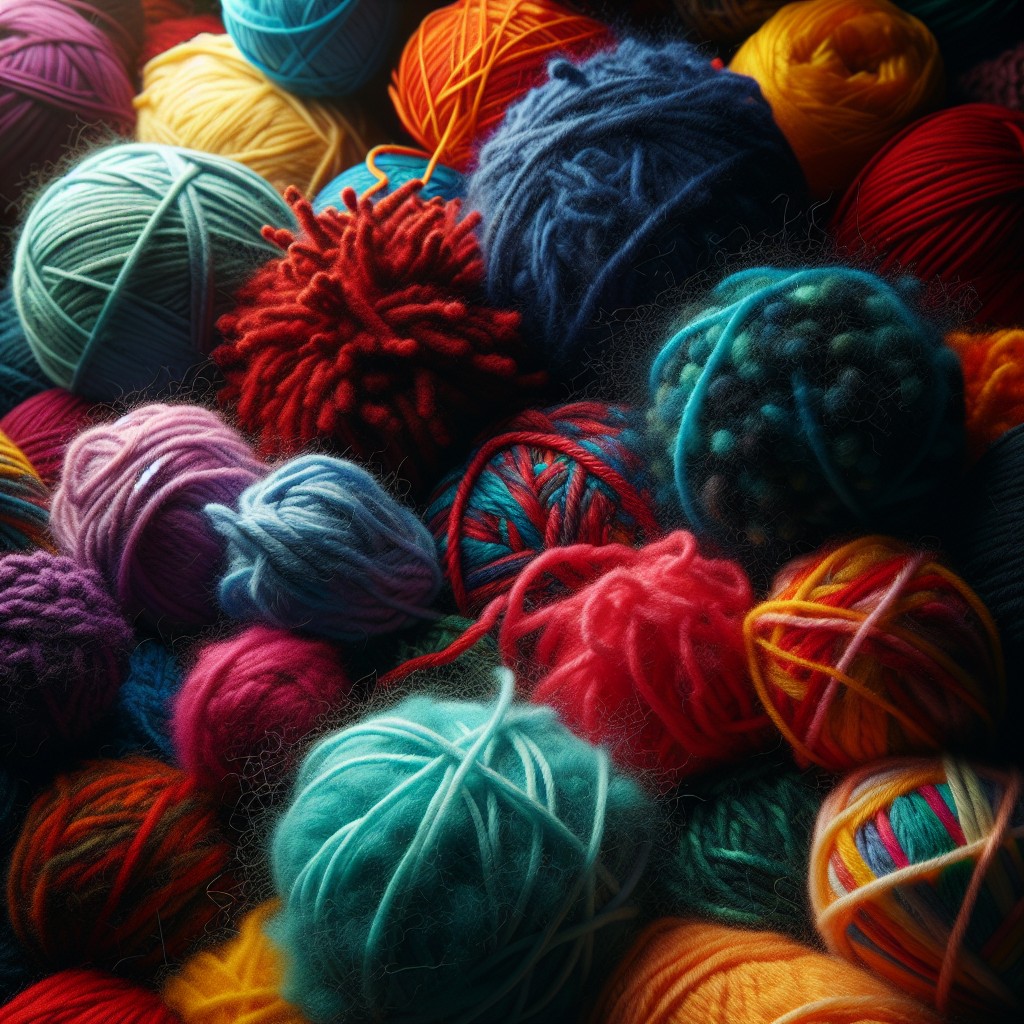
Commonly referred to as ‘bouclé’ in French, which translates to ‘curled’ or ‘looped‘, fuzzy yarn boasts an inherent fluffy or ‘fuzzy’ attribute.
It stands out due to its distinct texture that creates a haze around the stitched piece.
This soft haze is a result of the excessive fibers that stick out from the main yarn strand.
It is created using a base yarn that’s bound with a thread, trapping loose fibers to produce an overall fleecy aesthetic that appears ‘fuzzed’ up.
With variations in thickness, twist, and fiber content, fuzzy yarn forms a unique option for craft projects.
Characteristics of Fuzzy Yarn
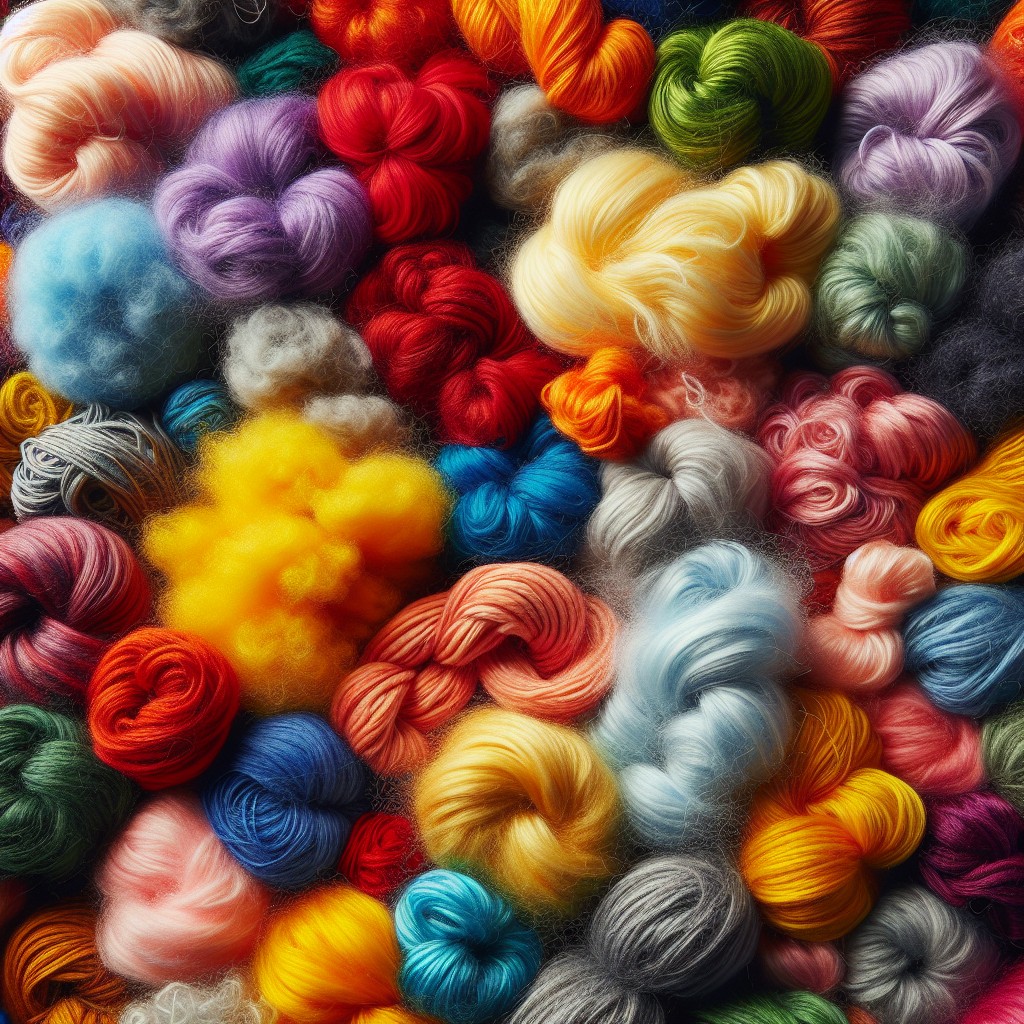
Heavily textured, with a soft, plush surface, fuzzy yarn is unique among its counterparts. Its hair-like strands, which can vary in length, give projects a whimsical touch. However, the texture and ‘fuzz’ can obscure stitch definition, making it an excellent choice for simpler patterns.
It comes in a spectrum of colors, from muted natural hues to vibrant shades, often dyed in patterns or gradients to create a striking effect. The elasticity and weight also differs between types, lending themselves to specific project requirements. Furthermore, the fuzziness factor can sometimes hinder a clear view of individual stitches, pushing many crafters towards using it with larger needles or hooks for better visibility.
Types of Fuzzy Yarn
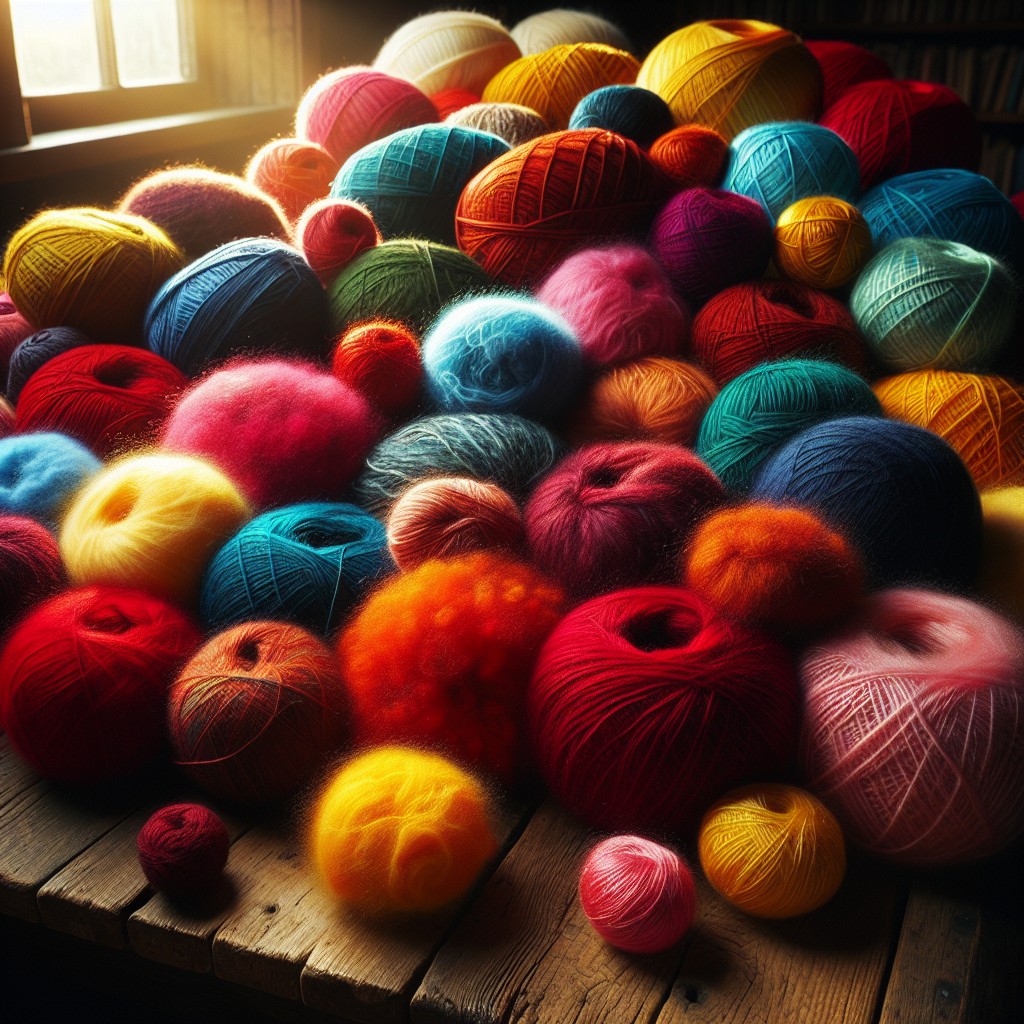
There is an impressive array of fuzzy yarn available for enthusiasts.
Chenille, for instance, is known for its softness and sheen due to its construction from short strands. It results in projects with a velvety texture.
Eyelash yarn is another type, with strands protruding from the main strand, resembling eyelashes and creating a fun, unique effect.
Bouclé yarn features loops, providing an interesting, textured surface when worked into a project.
Then there’s faux fur yarn, designed to mimic real fur in textures and even colourings, adding a luxurious feel to crafted items.
With these and many more types, customizing a crafting project becomes easy and an exciting journey of discovery. Remember, each type will behave differently when worked up, so it’s key to understand how the yarn needs to be handled.
Benefits of Using Fuzzy Yarn
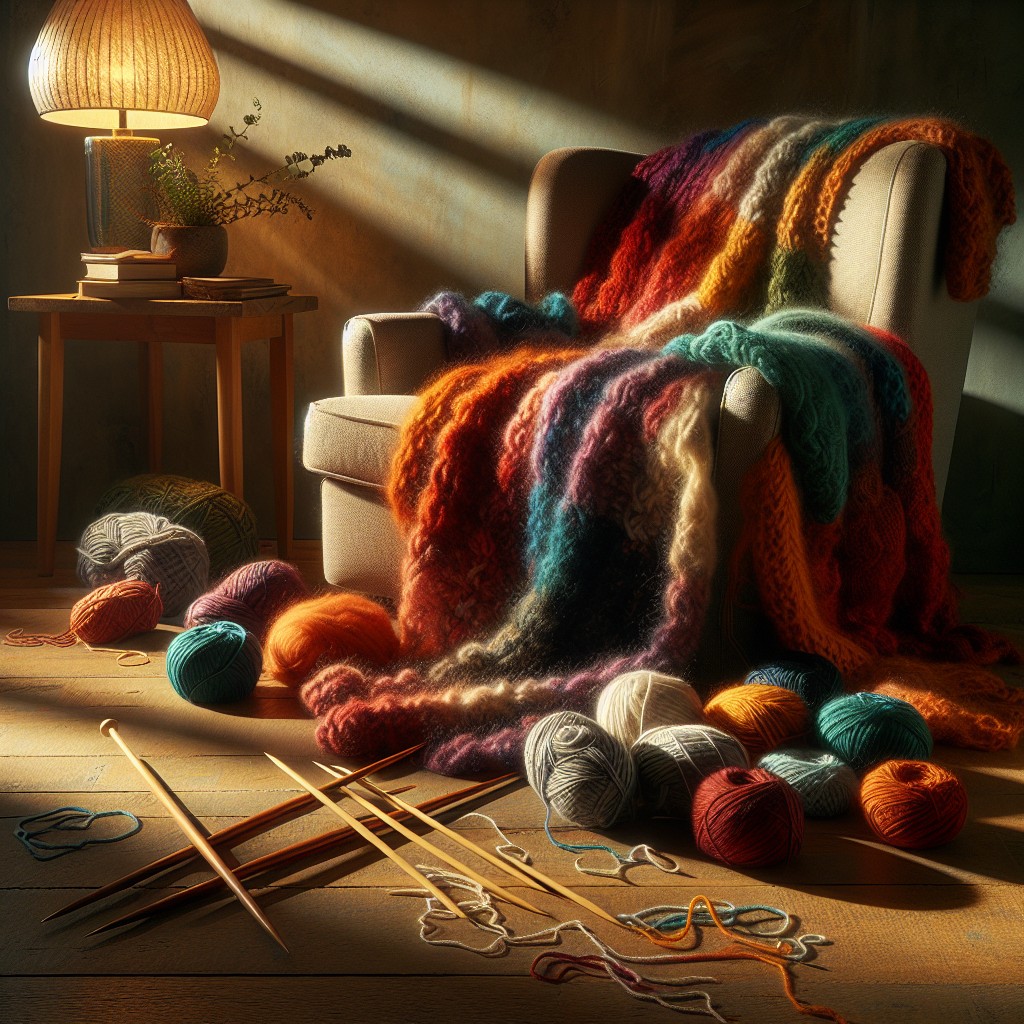
Beyond its soft touch and appealing texture, fuzzy yarn brings several advantages to your crafts:
1. Unique Aesthetic: Whether it’s for knitting or crocheting, this type of yarn adds a distinctive fluffy appearance, perfect for creating standout items like plush toys, scarves, and winter hats.
2. Insulation: Its fuzzy nature provides additional warmth, making it an excellent choice for cold-weather projects such as blankets, sweaters, and mittens.
3. Versatility: Fuzzy yarn comes in an array of vibrant colors and thicknesses, providing endless possibilities for different projects.
4. Easy Handling: Despite its fluffy nature, it’s not difficult to work with. Many crafters find it relatively easy to manipulate, once they get the hang of it.
5. Durability: Fuzzy yarn products can last for years when properly cared for, and often become beloved items due to their comfort and charm.
6. Creativity Booster: Its distinctive look can challenge and inspire crafters, pushing them to try new patterns and techniques.
Potential Challenges With Fuzzy Yarn
Working with this distinctive material, while rewarding, can present certain impediments. One notable issue is visibility; the fur-like textures of the yarn can obscure the stitches, making it tougher to see where the hook or needle needs to go next. This often makes the process slower as compared to using smoother yarns.
The fuzziness may also cause the yarn strands to clump together, which can result in unintentional knots. It’s important to watch out for this and gently untangle any knots encountered.
Moreover, rectifying errors can be more challenging. The fuzz of the yarn tangles easily in the process of undoing stitches, potentially resulting in waste.
Lastly, some beginners find that the fuzz of the yarn causes an itchiness to the fingers and hands while crocheting or knitting, though this can vary from brand to brand, and person to person.
Despite these challenges, with patience and practice, handling fuzzy yarn confidently is certainly achievable. Further sections will offer tips and tricks to counter these difficulties.
Care Instructions for Fuzzy Yarn
Handling fuzzy yarn requires a little more care than regular non-textured yarns. Here are some tips to keep in mind.
First off, always check the yarn label for cleaning instructions. Different materials mandate different care routines and failing to adhere to these can damage your yarn.
Machine washing is generally not advisable for fuzzy yarn items. The agitation could cause matting and potentially ruin the finished piece. Opting for a gentle hand wash in lukewarm water with a mild soap or detergents designed for delicate fibres would serve better.
Avoid wringing or twisting the fuzzy yarn while washing, as it can also cause matting or even break the fibres. Instead, carefully squeeze out excess water. To speed up drying, roll your piece in a towel and press gently to absorb the moisture.
Regular use may cause slight pilling or matting of the fuzzy texture. Consider lightly shaving the surface with a fabric shaver or sweater comb if this happens. Do this sparingly, taking care not to cut into your stitches.
Avoid high heat while drying. Laying the item flat to dry naturally is the safest method. If you’re tempted to speed up the drying process with a hairdryer or heater, resist it. The excess heat can potentially shrink or felt your yarn.
As always, one best way to maintain the quality of fuzzy yarn is to store it properly. Keep it in a cool, dry place, avoiding direct sunlight which can fade the colors over time.
Regular care and maintenance can ensure your fuzzy yarn projects stay soft and fluffy for years to come. Remember, proper care is key to maintaining the lifespan and beauty of any craft project.
Tips for Working With Fuzzy Yarn
To make the most out of fuzzy yarn, here are some practical pointers:
1. Needle Selection: Opt for larger, rounded needles or hooks. Not only do these facilitate simpler stitch identification, but they also help to prevent splitting the yarn.
2. Stitch Type: Work with simple stitch patterns. Due to the textured nature of fuzzy yarn, intricate designs often get lost amidst the fluff.
3. Tension: Maintain even, loose tension to prevent knots and tangles. Since it’s harder to see individual stitches, you don’t want to work the yarn too tightly.
4. Light Background: Use a light-colored background when working. This little trick enhances visibility, making it easier to see stitches.
5. Practice: Don’t fear experimentation. Get accustomed to the feel of the yarn with a practice swatch before commencing on the actual project.
6. Patience: Take your time while working with fuzzy yarn. Rushing things may lead to mistakes, and undoing them can be tough with this type of yarn.
Remember the key to an enjoyable crafting experience with fuzzy yarn is preparation and patience.
Common Projects Using Fuzzy Yarn
Fuzzy yarn, with its unique texture, lends itself beautifully to creating a variety of items, notably ones that delight both the maker and the recipient thanks to its plush, cozy feels.
Here are a few common project inspirations:
- Soft Toys: Bearing a teddy bear-like texture, fuzzy yarn instantly adds an enriching sensory experience to cuddly toys, making it the go-to option for soft toys and stuffed animals.
- Scarves and Shawls: Its fluffy nature offers unrivaled warmth, making it ideal for scarves, shawls, and other winter wear accessories carving out a cozy cocoon against icy chills.
- Sweaters and Cardigans: Fuzzy yarn provides an exceptional level of comfort and warmth, ideal for fashionable sweaters and cardigans, ensuring stylish coziness during winter days.
- Rugs and Throws: The yarn’s soft and luxurious feel makes it an excellent choice for home decor items such as throws and rugs, adding a touch of plush elegance to the ambiance.
- Hats and Mitts: Fuzzy yarn is great for knitting or crocheting comfy, stylish hats and mitts that keep the cold at bay while maintaining a trendy look.
- Pom-poms and Tassels: The fuzzy finish enhances the visual appeal of pom-poms and tassels, adding an attractive flair to several accessory projects.
These are just a few examples. The delightful texture and warmth of fuzzy yarn make it adaptable to a plethora of creative projects. Just remember, the fluffier the yarn, the more patience it may require to work with, but the end result is always worth the effort.
Best Practices for Crocheting With Fuzzy Yarn
To ensure an enjoyable crocheting experience while using fuzzy yarn, consider these techniques:
- Choose the right hook: A larger hook can help you see your stitches more clearly.
- Slow down: Crocheting with fuzzy yarn isn’t a race. Taking your time can prevent mistakes and reduce frustration.
- Stick to simple stitches: Complex patterns might be lost in the fuzziness. Single crochet and double crochet stitches work well.
- Use stitch markers: They can help you keep track of your work, making it easier to identify and correct any mistakes.
- Combine yarns: If a project proves challenging, consider using a smooth yarn in a similar color along with the fuzzy yarn. The smooth yarn will make it easier to see and work your stitches while maintaining the fuzzy appearance.
- Regularly check your tension: This is particularly crucial for beginners as fuzzy yarn can mask uneven tension.
- Practice first: If you’re new to working with fuzzy yarn, practice with a small swatch before starting your main project.
- Mind your ends: When finishing up, leave long tails. Fuzzy yarn can slip out of knots more quickly than other types.
Remember, patience is key; working with fuzzy yarn may require a bit more time and concentration, but the fluffy and cozy results are worth it.
Knitting Techniques Specific to Fuzzy Yarn
When knitting with fuzzy yarn, it’s important to keep a few key strategies in mind:
1. Slower Stitches: Be patient and give yourself permission to slow down. Fuzzy yarn hides stitch definition, so it can be difficult to see where to insert the needle.
2. Simple Patterns: Choosing simpler knitting patterns can prove beneficial due to the texture of the yarn. Let the yarn be the star of your project.
3. Use Larger Needles: Larger needles make it easier to knit with this type of yarn as they can handle the bulk of the fuzzy texture.
4. Visual Inspection: Regularly checking the back of your work for dropped stitches is crucial with fuzzy yarn; they can be easy to miss due to the fuzzy nature of the yarn.
5. Knit in Good Lighting: Given the fuzziness of the yarn, good lighting is essential to ensure you’re not missing any stitches or making unnecessary errors.
Remember, each fuzzy yarn will have its own personality, so continually adjust until you find the right rhythm and tension that suits the yarn and your project.
How to Choose the Right Fuzzy Yarn for Your Project
When selecting the ideal fuzzy yarn for your project, consider both the texture and weight. Texture impacts the final look and feel of your project, while weight influences the drape and stitch definition.
1. Texture: If your project requires fine detail, a lightly fuzzy yarn can enhance the visual appeal without obscuring detail. For a fluffier, cozier result, choose a heavily fuzzy yarn.
2. Weight: Light-weight yarns are suitable for delicate items like scarves and baby clothes. For warmer, more substantial pieces like blankets or sweaters, opt for medium to heavy weight fuzzy yarns.
3. Functionality: Consider the intended use of the finished product. If it’s an item that will be frequently laundered or heavily used, look for a fuzz-resistant yarn that will withstand wear and tear.
4. Color: Fuzziness can either enhance or blur yarn colours. Choose a color that harmonizes with the fuzziness level.
Feel the yarn, if possible. A physical examination can help determine if it delivers the desired comfort level and suits your project needs. Lastly, always remember to check the washing instructions to ensure that the yarn can be cleaned in a manner suitable for the final product.
Comparing Fuzzy Yarn With Other Types of Yarn
Fuzzy yarn, due to its unique characteristics, differs significantly from other types of yarn. Its main standout feature is the strands of material poking out from the main yarn string, giving it a fluffy appearance.
Contrarily, smooth yarns, such as cotton or merino wool, offer easy maneuverability and a neat finish. They’re ideal for beginners due to their even texture and easy handling.
Holding up fuzzy yarn against novelty yarns like ribbon or metallic yarns clearly translates the contrast. Novelty yarns bring an added element of sparkle or texture, yet can’t compete with fuzzy yarn’s warmth and comfort.
Boucle yarn, with its loops and curls, creates intricate textures. However, it falls short in providing the continuous fluffiness that fuzzy yarn imparts.
Variegated yarn, despite creating beautiful color patterns, lacks the soft, plush effect observed in fuzzy yarn.
In essence, fuzzy yarn offers an unparalleled visual richness and physical comfort when compared to other options, each having its own strengths and best use scenarios.
Sourcing Ethical and Sustainable Fuzzy Yarn
When it comes to sourcing materials for your craft projects, considering ethical and sustainable options is vital in today’s age. Here are several points to guide you in picking out environmentally-friendly fuzzy yarn:
1. Look for Natural Fibers: Yarns made from organic cotton, wool, bamboo, silk, and linen are renewable, biodegradable and free from harmful chemicals, hence offering an eco-friendly choice.
2. Fair Trade Certified: Ensure that the yarn is ethically sourced by checking for Fair Trade certification. This means the producers receive a fair wage and work in decent conditions.
3. Animal-Friendly Options: If you’re opting for animal-derived yarn like wool, consider those marked as ‘cruelty-free’ or ‘mulesing-free’, implying that the sheep were not harmed during the yarn production process.
4. Consider Recycled Yarn: Some companies produce yarn from recycled textile waste, making these yarns a more sustainable alternative.
5. Packaging: Lastly, select brands that use minimal and recyclable packaging to reduce waste.
By keeping these tips in mind, any crafter can contribute positively to the environment while enjoying the benefits of fuzzy yarn.
Safety Considerations When Working With Fuzzy Yarn
While fuzzy yarn has a fond place in the hearts of many craft enthusiasts, it also comes with a handful of risks that need attention.
Firstly, the tiny fibers that create its unique texture are prone to shedding. If they become airborne, they may irritate the respiratory system or the eyes. Therefore, working in a well-ventilated room and occasionally pausing to aerate the area can minimize the risk.
Secondly, this yarn type can be more flammable, especially if it is synthetic. It’s pertinent to avoid open flames when crafting and storing these projects.
Lastly, it can be a choking hazard for small children and pets if small yarn pieces break off. Creating tight stitches and not leaving loose ends can help to minimize this risk.
By maintaining mindful practices, you can enjoy the warmth and allure of fuzzy yarn, while keeping safety at the forefront.
Recycling and Repurposing Fuzzy Yarn
No yarn needs to go to waste, even if it’s a fuzzy and fantastically textured one. Recycled or repurposed fuzzy yarn can bring your craft projects to life in ways you had not anticipated.
Here are some ways to effectively reuse your fuzzy yarn:
- 1. Felted Projects: Due to its unique texture, dyed fuzzy yarn works extraordinarily well for felted projects. These can range from coasters, bags to even cute, fuzzy animals.
- 2. Trimmings: Fuzzy yarn is ideal for trims and edgings on woven or knitted items. It lends a luxurious touch to blankets, throws, and cushions.
- 3. Stitch Markers: An unconventional approach, but short bits of colourful fuzzy yarn can be highly effective—and sustainable—stitch markers.
- 4. Stuffing: Consider utilizing leftover fuzzy yarn as stuffing for knitted or crocheted toys– its texture adds an interesting touch.
Remember, every creative use of fuzzy yarn not only reduces waste but also enriches your project with a bespoke charm.
FAQ
What is the name of the fuzzy yarn?
The name of the fuzzy yarn is Mohair.
What is that really soft yarn called?
The softest type of yarn is typically cashmere.
What do you call fluffy wool?
Fluffy wool is commonly referred to as Angora wool, which is derived from the Angora rabbit and known for its softness, heat retention, and moisture-wicking properties.
How does the production process of fuzzy yarn differ from other yarn types?
Fuzzy yarn’s production process differs from other yarn types in that it typically involves spinning fibers with longer pile lengths to create its characteristic fluffy texture.
What types of projects are best suited for using fuzzy yarn?
Fuzzy yarn is best suited for projects such as scarves, sweaters, toy crafts, eye-catching accessories and warm winter socks because of its soft texture and rich appearance.
Which stitches and techniques work well with the texture of fuzzy yarn?
Stitches and techniques like single crochet, half double crochet, or knitting simple stockinette stitch work well with the texture of fuzzy yarn as they don’t overshadow the yarn’s fluffy nature.
